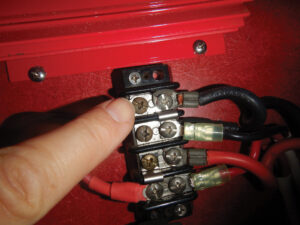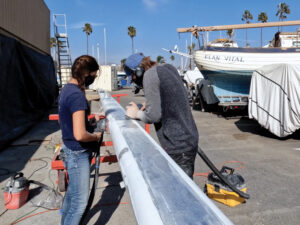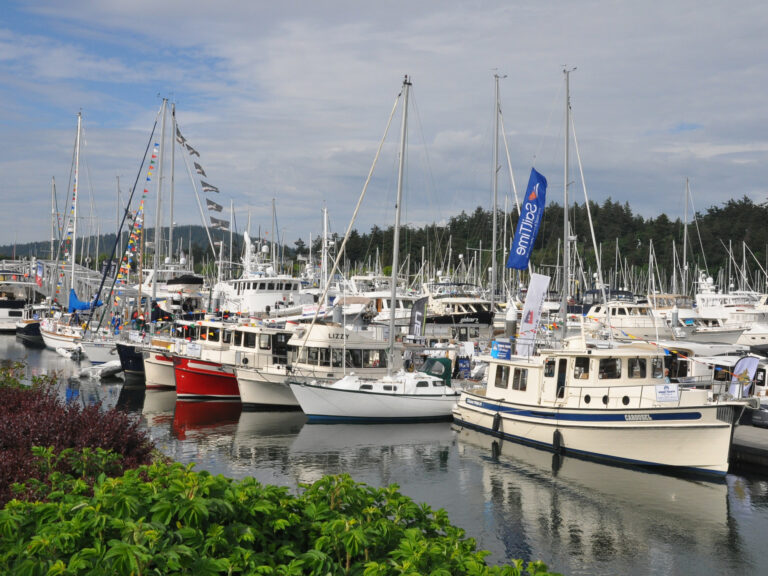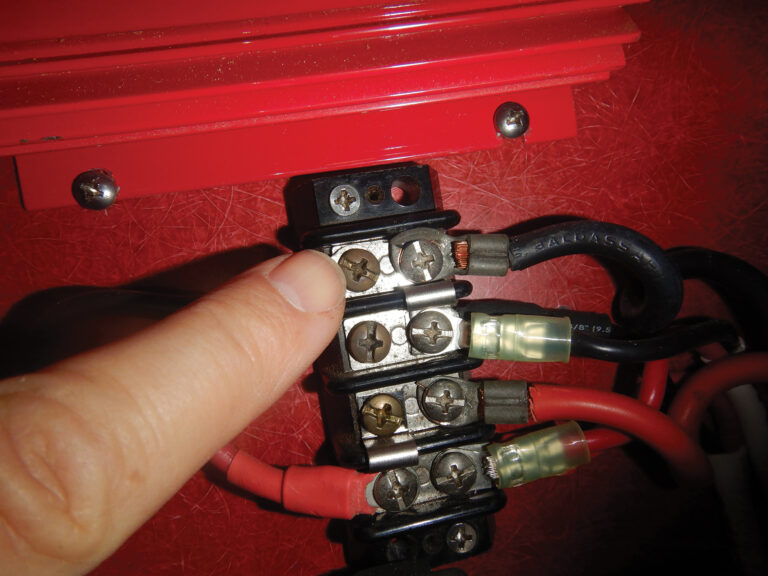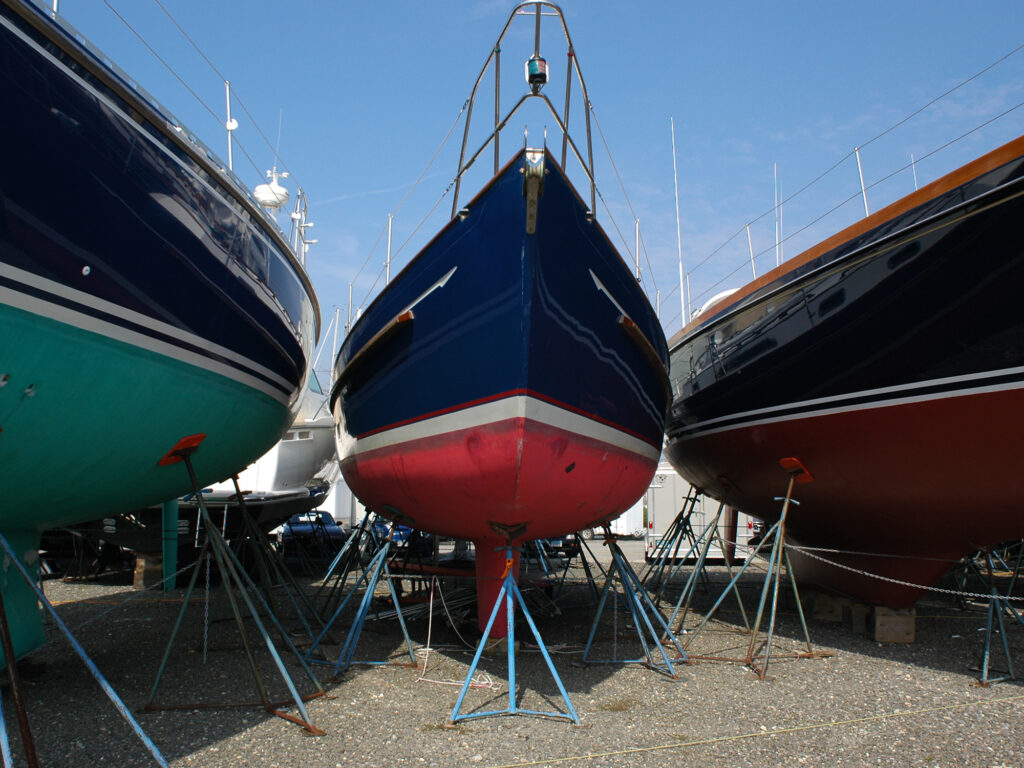
There’s an art to ending the season. A good boatyard with a capable crew smooths the transition from sea to land.
Every skipper who faces the fall haulout ritual can benefit from a glimpse at how other yards handle sailboats. Most yards utilize Travelifts and U-shaped lift piers, but the way that a crew maneuvers a sailboat into the lift slings, hauls, and blocks can add valuable insight. There are subtleties in the way that the lift operator snugs up slack in the slings and smoothly controls the powerful hydraulic winches. Attention to detail reveals competency.
Equipment condition is important too. Beware of rusty lifting cables, frayed slings, and tires that show signs of sun rot and sidewall damage.
And, as one old salt put it, “Even in the best of yards, you don’t want your boat to be the biggest boat that the yard has ever hauled.”
There are ways to expedite the prehaul boat preparation. Remove the sails, dodger, and Bimini top, and offload provisions and gear for the winter. It’s usually a lot easier to do this dockside rather than after the haulout. Also make sure the holding tank has been pumped out, the knotmeter transducer is retracted, and the yard manager or lift operator has an underwater profile picture or drawing of your boat.
Some yards allow owners to pilot their boats into the Travelift slip, while others don’t. In either case, boathandling skills are tested, and good and bad habits stand out. For example, most lift operators make good use of long boat hooks. They use them to tug on a rail or cleat. But some also reach for lifeline stanchions when a big pull is needed to coax the boat sideways. Even worse is when a lift operator uses an upper shroud to stop the boat’s forward motion. Skilled sailboat handlers can nudge a vessel into the Travelift slip without such rigging torment.
If you’re engaged in a DIY approach to the lift slip, you must make sure that the boat is ready to be hoisted. Often a headstay or backstay needs to be disconnected at the deck. If so, cinch up a halyard and set running backstays to keep the mast stabilized. Double-check to make sure that the lift operator and sling crew know where your boat’s vulnerable folding or feathering prop resides.
Strap locations are critical. Catching the sling on a prop blade is a costly mistake, and it’s the reason why most experienced lift operators appreciate that profile picture of the boat’s underbody. Also, they often use a long pole or boat hook as a probe to make sure there’s plenty of prop-to-sling separation. The two slings are connected with a line to prevent slippage, and are padded or sleeved where the webbing touches the topsides.
Shallow Travelift piers and deep-draft vessels are a challenge. A skilled crew uses the upper portion of a rising tide to haul deeper-draft vessels, with a plan to finish during the last part of the flooding. This extra insurance often comes in handy. Note the high-water time on the day you go, and see how the yard crew handles scheduling.
Good timing is just as essential during the ebbing side of the tidal cycle. This is one reason why many yards add a hydraulic trailer to the mix. Hauled boats can be placed in a trailer to be moved, pressure-washed and delivered to the blocking location while the Travelift is free to haul the next boat.
Less common are crane-hoist haulouts and traditional marine railways that follow the slope of the bottom during the transition from water to land. With crane hoists, it’s important that the cable is attached to a steel framework or spreader bars to keep the slings from overcompressing the sheer. Marine railways use a cradle fit to the shape of a specific hull. It’s secured to a railway carriage that’s run into the water, where the vessel powers, or is pushed, into the cradle. These methods are viable but slower.
The second task on the annual haulout list is bottom-cleaning effort. Over the years, this work has become more efficient and environmentally friendly. Residue from biological growth and bottom paint must be retained, preventing contaminants from washing back into the bay. Most antifoulant significantly reduces growth. High-pressure water blasting can help prep the surface for next season’s bottom paint.
Finally, the boat is moved to its designated space, in a growing number of cases by a boat trailer with a hydraulically raised and lowered frame and padded arms. Boatyards benefit from these trailers because hauled vessels can be placed closer together. DIY owners often prefer yards where space between boats is greater, leaving more room to tackle projects.
Blocking up sailboats, especially with masts stepped, is an art unto itself. Part of the challenge stems from the varied underbody shapes and draft differences among modern sailboats. In addition, many boatyard storage areas are not paved—sometimes not even gravel-coated. These issues are exacerbated when winter storms besiege the blocked-up fleet. Many owners look for better yards in less-populated areas where land is less expensive and storage is more available.
The best yards don’t skimp on screw jack stands. They carefully block each sailboat’s keel and run chains between port and starboard opposing stands. Each jack stand is aligned so that the pad against the hull and the supporting column of the stand are as perpendicular as possible.
When blocking is done on unpaved surfaces, especially in poor drainage areas, plywood pads are used under each tubular foot. In most cases, yard crews check stand tension regularly during the season, and specifically before major forecast weather.
Before signing a haul-store-launch contract, make sure you are aware of the date you must be ready to launch. Yards usually follow a first-out, last-in and last-in, first-out format, somewhat like sardine packing.

